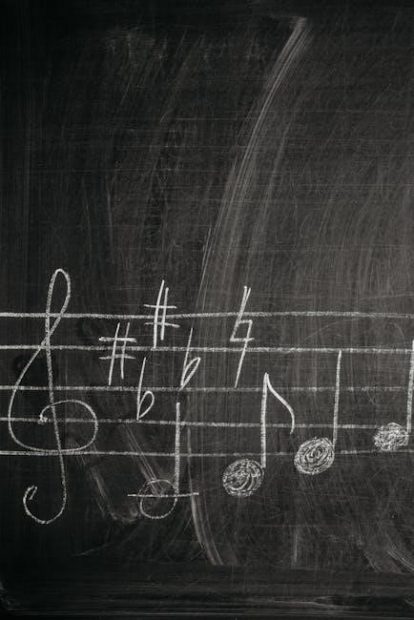Mastering bass clef notes is essential for pianists, bassists, and singers. PDF worksheets offer structured exercises to practice note recognition and improve sight-reading skills effectively from any device.
What is the Bass Clef?
The bass clef, also known as the F clef, indicates that the fourth line of the staff represents the note F. It is commonly used for lower-pitched instruments like cellos and bass guitars. The bass clef symbol, a stylized letter F with two dots, is placed at the beginning of the staff. The lines of the bass clef staff are remembered using the mnemonic “Great Big Dogs Fight Animals,” corresponding to G, B, D, F, A. The spaces are recalled with “All Cows Eat Grass,” representing A, C, E, G. Notes can be placed on lines, in spaces, or on ledger lines above or below the staff. Middle C is a key landmark, located on the first ledger line below the staff in the bass clef. Understanding the bass clef involves recognizing its symbol, noting the order of lines and spaces, and using landmarks for quick identification.
Importance of Learning Bass Clef Notes
Mastery of bass clef notes enhances musical literacy, enabling performers to interpret sheet music accurately. It is vital for pianists, bassists, and composers, as it allows them to communicate musical ideas clearly. Learning the bass clef expands one’s versatility, making it easier to play or sing in ensembles. It also improves sight-reading skills and overall musicianship. For instance, bass clef proficiency aids pianists in reading left-hand parts and bassists in performing complex lines. Additionally, composers rely on the bass clef to notate lower-pitched instruments effectively. With PDF resources, learners can access structured exercises to practice note recognition and interval understanding, which are key to fluent reading. Regular practice with these materials helps build confidence and accuracy, making the bass clef an indispensable tool for any musician seeking to broaden their skills and deepen their understanding of music theory.
Basic Structure of the Bass Clef Staff
The bass clef staff consists of five lines and four spaces, each representing specific notes. The lines, from bottom to top, are G, B, D, F, A, remembered by the mnemonic “Great Big Dogs Fight Animals.” The spaces, from bottom to top, are A, C, E, G, recalled as “All Cows Eat Grass.” Notes can be placed on the lines, in the spaces, or above and below the staff, sometimes requiring ledger lines for pitches beyond the standard range. This structured layout is crucial for accurately reading sheet music. PDF resources provide exercises to practice note recognition and placement, helping musicians master the bass clef staff.

Understanding the Bass Clef Staff
The bass clef staff features five lines and four spaces, with notes placed on or between them. Ledger lines extend the staff for higher or lower pitches, aiding accurate notation. PDF guides provide clear visuals and exercises to master this fundamental music theory concept.
Lines of the Bass Clef Staff
The bass clef staff consists of five lines, each representing specific notes. From bottom to top, these lines are labeled G, B, D, F, and A. Notes placed directly on these lines correspond to these letter names. The lines serve as the primary framework for reading pitches in bass clef notation. Middle lines, such as the third line (D), are often used as reference points for quick recognition. PDF resources like those from www.musictechteacher.com provide exercises to practice identifying notes on the lines. Understanding the sequence of these lines is crucial for accurate note reading and sight-reading skills. By mastering the lines of the bass clef staff, musicians can effectively interpret musical pitches and intervals with confidence.
Spaces of the Bass Clef Staff
The bass clef staff contains four spaces between its five lines. These spaces are labeled, from bottom to top, as A, C, E, and G. Notes placed within these spaces correspond to these letter names. The spaces are essential for reading pitches in bass clef notation, as they represent specific musical notes. For example, the first space above the staff is A, the second is C, the third is E, and the fourth is G. Understanding the sequence of these spaces helps musicians identify notes quickly. PDF worksheets often include exercises to practice recognizing notes in these spaces. By mastering the spaces of the bass clef staff, learners can improve their sight-reading skills and accurately interpret musical pitches. Regular practice with these exercises ensures confidence in reading bass clef notation fluently.
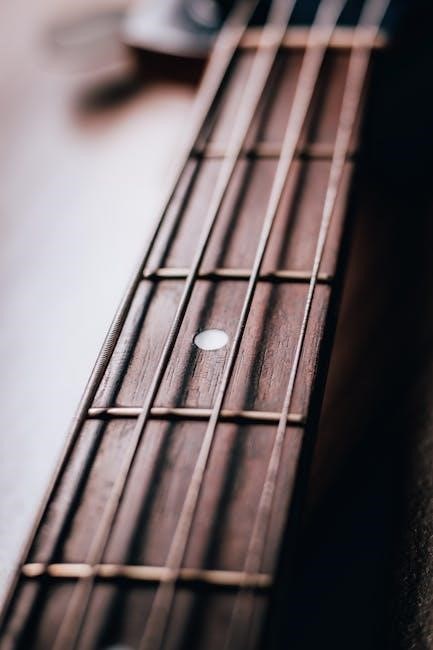
Position of Notes on the Staff
Position of Notes on the Bass Clef Staff
Notes on the bass clef staff can be placed on the lines, in the spaces, or above and below the staff. Each position corresponds to a specific pitch. The lines of the bass clef staff are labeled, from bottom to top, as G, B, D, F, and A. The spaces are labeled A, C, E, and G. Notes above the staff are marked with ledger lines, while notes below the staff are also indicated with ledger lines. Sharps and flats modify the pitch of these notes. Understanding the position of notes is crucial for accurate sight-reading. PDF worksheets often include exercises to practice identifying notes in various positions. By mastering the placement of notes on the bass clef staff, musicians can improve their ability to read and play music confidently. Regular practice with these materials ensures familiarity with the staff and enhances overall musical literacy.

Identifying Bass Clef Notes
Mastery of bass clef notes begins with the musical alphabet and landmark recognition. PDF worksheets provide exercises to identify notes above, below, and on the staff, enhancing sight-reading skills effectively.
Notes Above the Bass Clef Staff
Notes above the bass clef staff are positioned on or between ledger lines, which extend beyond the staff. These notes follow the musical alphabet sequence (A-G) and are identified by their placement relative to the staff lines and spaces. For example, the first ledger line above the staff represents a high B, while the second line corresponds to a high C. PDF worksheets often include exercises to practice identifying these higher notes, reinforcing sight-reading and note recognition skills. Mastering this concept is essential for accurately reading bass clef music, especially for instruments like the cello or trombone.
Notes Below the Bass Clef Staff
Notes below the bass clef staff are placed on or between ledger lines that extend downward. These notes follow the reverse of the musical alphabet sequence (G-F-E-D-C-B-A). The first ledger line below the staff corresponds to a low G, while the second line represents an F. As you move further down, the notes continue in descending order. PDF worksheets often include drills to help musicians identify these lower notes accurately. Understanding this concept is crucial for reading bass clef music, especially for instruments like the cello or double bass. Regular practice with these exercises enhances sight-reading and note recognition skills, making it easier to interpret bass clef notation in various musical contexts.
Landmark Notes for Quick Recognition
Landmark notes are essential for quickly recognizing notes on the bass clef staff. These notes serve as reference points, helping musicians navigate the staff with ease. The most commonly used landmarks are middle C, G on the bottom line, and F on the fourth line. These notes are often circled or highlighted in bass clef notes PDF worksheets to emphasize their importance. By memorizing these landmarks, players can identify other notes relative to their positions. For example, the note directly above G on the third line is A, and the note below F on the fourth line is E. This method reduces confusion and speeds up sight-reading. Regular practice with these landmarks improves accuracy and builds confidence in reading bass clef notation. PDF exercises often include drills focusing on these key notes to reinforce their recognition.

The Musical Alphabet and Bass Clef
The musical alphabet (A–G) applies to the bass clef, starting with A. Bass clef notes pdf resources use this sequence to help musicians identify notes accurately.
Sequence of the Musical Alphabet
The musical alphabet consists of seven natural notes: A, B, C, D, E, F, and G. This sequence repeats in a cyclical pattern, forming the foundation of music notation. In the bass clef, these notes are arranged to correspond with the staff lines and spaces. Understanding the sequence is essential for identifying notes, as it allows musicians to recognize patterns and intervals. Bass clef notes PDF resources often highlight this sequence to aid in memorization and practice. By mastering the musical alphabet, learners can more easily navigate the bass clef staff and accurately identify notes within musical compositions. This fundamental knowledge is a critical step in developing proficiency in reading bass clef notation effectively.
Applying the Musical Alphabet to Bass Clef Notes
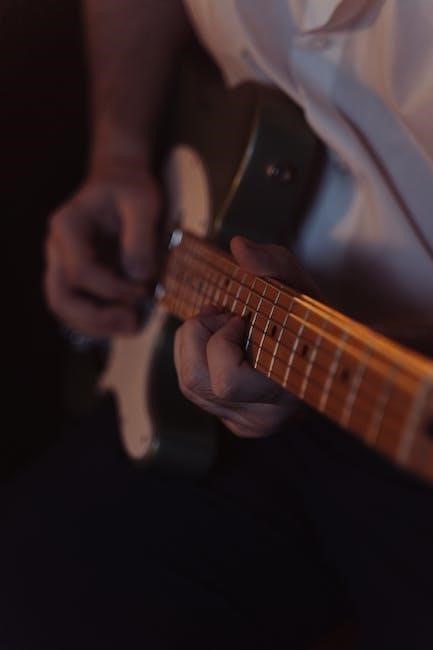
Applying the musical alphabet to bass clef notes involves mapping the sequence of letters (A, B, C, D, E, F, G) to the lines and spaces of the bass clef staff. Each line and space is assigned a note based on its position, and this sequence repeats both above and below the staff. For example, the lines of the bass clef staff correspond to G, B, D, F, A (often remembered by the phrase “Great Big Dogs Fight Animals”), while the spaces correspond to A, C, E (remembered as “All Cows Eat”). Middle C, a key reference point, sits on the first ledger line below the staff. By counting up or down the musical alphabet, learners can identify notes like E, G, F, and D relative to middle C. Bass clef notes PDFs often include exercises that reinforce this application, helping musicians develop fluency in note recognition.
Practical Tips for Reading Bass Clef Notes
Start by identifying the staff lines and spaces, using mnemonics like “Great Big Dogs Fight Animals” for lines and “All Cows Eat” for spaces. Practice scales and arpeggios to build familiarity. Use bass clef notes PDFs for targeted exercises, focusing on ledger lines and common patterns. Sight-read regularly to improve speed and accuracy, and apply musical terms like dynamics and articulation to enhance understanding. Break difficult passages into smaller sections and gradually increase tempo. Consistent practice ensures mastery of bass clef notation.
How to Draw the Bass Clef
Drawing the bass clef begins with a vertical staff line. The clef symbol, resembling a stylized “C,” is placed to the left. The open part of the “C” faces downward and curves around the second line from the bottom, indicating the note F. Ensure the symbol is proportional, with the filled-in circle at the top and the curved line extending smoothly. Practice consistently to maintain proper form and alignment with the staff. Using a bass clef notes PDF can provide clear examples and help avoid common mistakes, ensuring the clef is easily recognizable and correctly positioned for accurate musical notation.
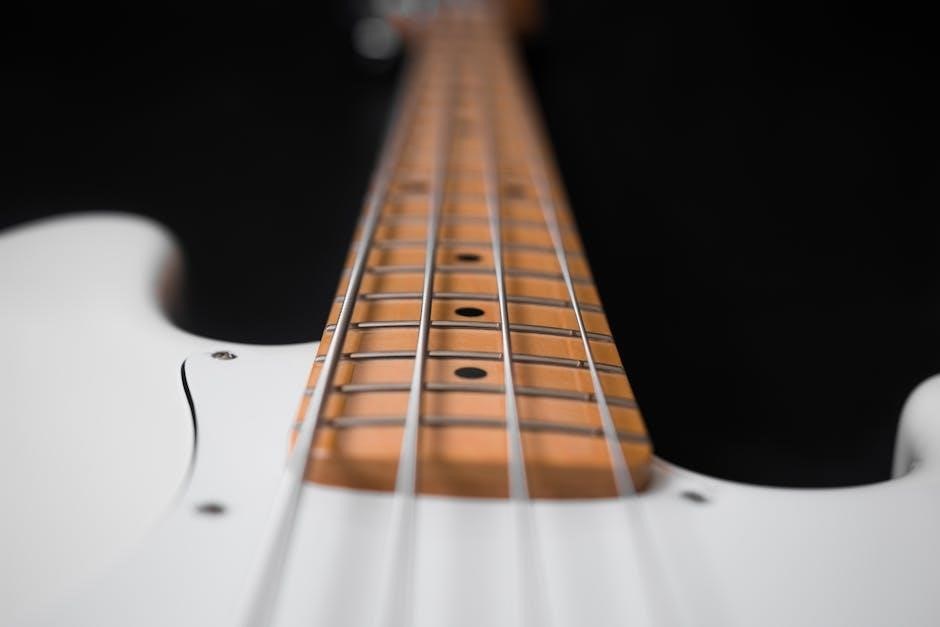
Common Bass Clef Notes and Their Positions
Learning the positions of common bass clef notes is essential for reading music effectively. The lines of the bass clef staff are assigned the notes G, B, D, F, A (Great Big Dogs Fight Anymore). The spaces correspond to the notes A, O, G, B, D (All Over Good Boys Do). Middle C, a key reference note, sits at the bottom of the treble clef staff and the top of the bass clef staff. Notes above the staff are marked with ledger lines, extending the range upward. Below the staff, notes are also indicated with ledger lines, extending downward. Practicing with a bass clef notes PDF can help reinforce these positions and improve sight-reading skills. Focus on recognizing patterns and landmarks to build confidence in identifying notes quickly and accurately.
Sharps and Flats in Bass Clef Notation
Sharps (#) and flats (♭) are essential in bass clef notation to indicate pitch alterations. A sharp raises a note by one semitone, while a flat lowers it by one semitone. These accidentals are placed to the left of the note they modify. For example, a sharp on F creates F#, and a flat on B creates B♭. Natural signs (♮) restore the pitch to its original state. In bass clef, sharps and flats are often used in key signatures or as accidentals within a measure. Ledger lines may be needed to notate sharps or flats outside the staff.
Practicing with a bass clef notes PDF can help identify sharps and flats quickly. Focus on recognizing their positions relative to notes and understanding their impact on pitch. This skill enhances sight-reading and performance accuracy in bass clef music.
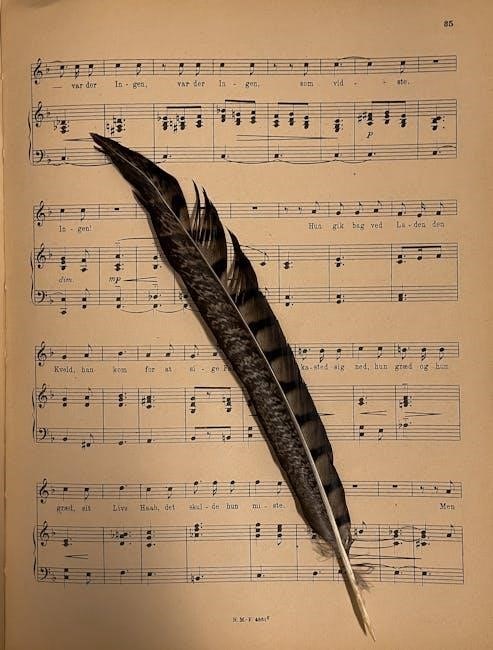
Bass Clef Notes in Musical Context
Bass clef notes are fundamental in creating harmony and melody in musical compositions. They are often used by lower-pitched instruments to establish the musical context and structure.
Notes and Rests in Bass Clef
Notes and rests in the bass clef are essential for conveying rhythm and pitch in musical compositions. Each note has a specific value, such as whole, half, quarter, eighth, and sixteenth notes, which indicate duration. Rests, on the other hand, represent silence and are equally important for maintaining rhythm. In the bass clef, notes are placed on the five lines and four spaces of the staff, with their positions determining pitch. For example, the lines of the bass clef staff are G, B, D, F, A, while the spaces are A, C, E. Rests are placed in the same manner as notes, with their value indicated by their shape and position. Understanding the relationship between notes and rests is crucial for accurate musical interpretation. Proper notation ensures clarity, allowing musicians to perform pieces effectively.

Dynamics and Articulation in Bass Clef Music
Dynamics and articulation are vital elements in bass clef music, adding depth and emotion to compositions. Dynamics refer to the loudness or softness of the music, indicated by markings such as f (forte) for loud and p (piano) for soft. Articulation defines how notes are attacked, with symbols like staccato (short and detached) and legato (smooth and connected). These markings guide musicians to interpret the music correctly, enhancing its expressive qualities. In bass clef notation, dynamics are typically placed below or above the staff, while articulation marks are placed close to the notes they affect. Understanding and applying these elements ensures a more nuanced and engaging performance. Proper use of dynamics and articulation brings musical compositions to life, making them more impactful and meaningful for both performers and listeners;
Intervals in Bass Clef Notation
Intervals in bass clef notation represent the distance between two pitches. They are fundamental for understanding harmony, chord progressions, and melodic structure. Intervals are categorized as major, minor, perfect, or diminished, depending on the number of whole and half steps between the notes. For example, a major third consists of four semitones, while a perfect fifth spans seven semitones. In bass clef, intervals are often used to construct chords and to analyze melodic lines. Musicians use the circle of fifths to identify the relationship between keys and intervals. Understanding intervals is crucial for reading bass clef notes, as they provide insight into the harmonic structure of music. Practicing interval recognition improves sight-reading and enhances musical interpretation. Whether composing or performing, mastery of intervals is essential for working with bass clef notation effectively.
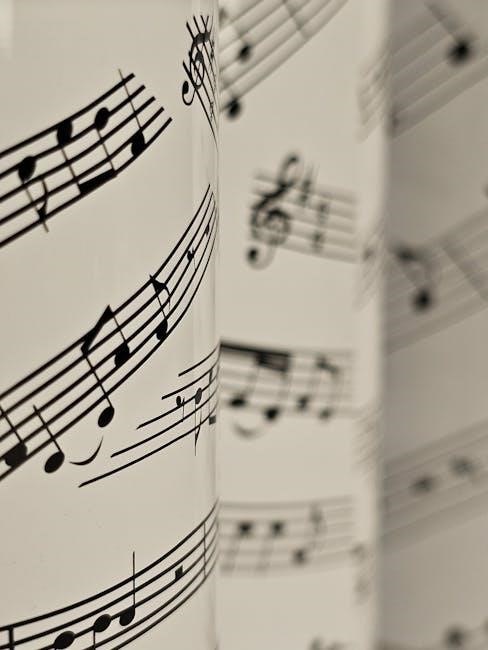
Resources for Learning Bass Clef Notes
Free PDF worksheets, online tools, and recommended books provide essential resources for mastering bass clef notes. These materials offer structured exercises and interactive practice to enhance note-reading skills effectively.
Free PDF Worksheets for Bass Clef Note Reading
Free PDF worksheets are an excellent resource for practicing bass clef note reading. These worksheets are widely available online and offer a variety of exercises tailored to different skill levels. Many music education websites, forums, and educational platforms provide downloadable PDFs that focus specifically on bass clef notation. These worksheets often include drills for identifying notes on the staff, understanding ledger lines, and recognizing patterns. They may also cover accidentals like sharps and flats, helping learners master more complex note recognition. Worksheets are structured to progress from basic to advanced levels, making them suitable for both beginners and experienced musicians. Additionally, some PDFs include exercises for sight-reading and interval recognition, further enhancing musical literacy. By using these resources, students and teachers can create effective practice routines for mastering bass clef notes.
Online Tools for Practicing Bass Clef Notes
Online tools provide interactive and engaging ways to practice bass clef notes. Apps like Note Rush and Piano Maestro offer exercises tailored to bass clef recognition, with interactive games and drills. These tools often include real-time feedback, helping users improve accuracy. Websites such as Teoría and MusicTheory.net feature browser-based exercises for identifying notes on the bass clef staff. Many platforms allow users to customize practice sessions, focusing on specific ranges or complexities. Additionally, apps like Tenuto and Flashnote cater to both iOS and Android users, offering comprehensive note-reading exercises. These tools are ideal for self-paced learning and can be used alongside traditional methods. By leveraging technology, musicians can enhance their bass clef note-reading skills efficiently and enjoyably. Regular use of these tools can significantly improve fluency and confidence in reading bass clef notation.
Recommended Books for Bass Clef Note Study
Several books are highly recommended for mastering bass clef notes, offering comprehensive lessons and exercises. “The Musician’s Guide to Reading and Writing Music” by Gary E. Anderson provides an in-depth exploration of music notation, including bass clef. “Alfred’s Basic Piano Library: Note Speller” by Willard A. Palmer is another excellent resource, focusing on note recognition and spelling in both treble and bass clefs. “Harmonic Function in Chromatic Music” by Miguel A. Roig-Francolí is ideal for advanced learners, covering complex harmonies and note relationships. These books are widely available in PDF formats, making them accessible for digital learners. They offer structured lessons, practical exercises, and clear explanations, making them essential for musicians aiming to excel in reading bass clef notes. These resources complement online tools and worksheets, ensuring a well-rounded learning experience.
Mastering bass clef notes is a rewarding journey that enhances your musical skills. Consistent practice and patience are key to reading music confidently. Use the provided PDFs and resources to refine your abilities.
Final Tips for Mastering Bass Clef Notes
To master bass clef notes, start by practicing sight-reading regularly. Use mnemonics like “Great Big Dogs Fight Animals” for lines and “FACE” for spaces. Flashcards can help reinforce note recognition. Group notes into patterns or intervals to simplify learning. Focus on octaves as reference points to build accuracy. Incorporate scales and arpeggios into your practice to improve familiarity. Use free PDF worksheets to test your skills and track progress. Break difficult passages into smaller sections and gradually increase speed. Record yourself to identify areas for improvement. Stay relaxed and patient, as consistent effort leads to mastery. Remember, effective practice is key to reading bass clef notes with confidence and precision.
Encouragement for Continuous Practice
Consistent practice is the cornerstone of mastering bass clef notes. Celebrate small victories, like recognizing notes more quickly or reading a challenging passage accurately. Set achievable daily goals, even if it’s just 10–15 minutes of practice. Remind yourself that progress takes time, and every effort builds skills. Use free PDF worksheets to track your improvement and stay motivated. Surround yourself with a supportive environment, whether it’s a teacher, fellow musicians, or online communities. Embrace challenges as opportunities to grow and refine your skills. Stay positive and remind yourself why you started learning—music is a lifelong journey of discovery and joy. Keep pushing forward, and soon reading bass clef notes will become second nature.
